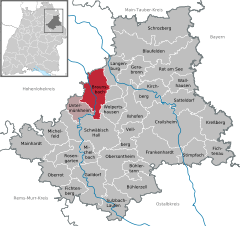Braunsbach
| Braunsbach | ||
|---|---|---|
| ||
 Braunsbach | ||
Location of Braunsbach within Schwäbisch Hall district 
 | ||
| Coordinates: 49°11′56″N 09°47′29″E / 49.19889°N 9.79139°ECoordinates: 49°11′56″N 09°47′29″E / 49.19889°N 9.79139°E | ||
| Country | Germany | |
| State | Baden-Württemberg | |
| Admin. region | Stuttgart | |
| District | Schwäbisch Hall | |
| Government | ||
| • Mayor | Frank Harsch | |
| Area | ||
| • Total | 52.85 km2 (20.41 sq mi) | |
| Population (2012-12-31)[1] | ||
| • Total | 2,447 | |
| • Density | 46/km2 (120/sq mi) | |
| Time zone | CET/CEST (UTC+1/+2) | |
| Postal codes | 74542 | |
| Dialling codes | 07906 | |
| Vehicle registration | SHA | |
| Website | www.braunsbach.de | |
Braunsbach is a municipality in the district of Schwäbisch Hall in Baden-Württemberg in Germany. It is on the Kocher river, about 15 kilometres (9.3 mi) from the county seat of Schwabisch Hall. The town is bordered to the north by the town Kuenzelsau, the county seat of Hohenlohe, in the east by the town of Langenburg, on the southeast by Wolpertshausen, in the south by the town of Schwäbisch Hall and on the west by Untermünkheim and Kupfer in Hohenlohe.
Braunsbach was formed in February 1972 by the voluntary merger of the formerly independent communities of Arnsdorf, Braunsbach, Döttingen, Geislingen am Kocher, Jungholzhausen, Orlach and Steinkirchen.
Points of interest
- Braunsbach castle, in part built in 1250[2]
- Protestant church in the castle[2]
- Döttingen Gate Braunsbach (rest of the wall surrounding the village)[2]
- Tierberg castle (13th century), the former hunting lodge of the princes of Hohenlohe[2]
- Döttingen Castle (built in the 16th century), now hotel and restaurant[2]
- House of the former Mayor J. M. Gronbach in Orlach (now House Schumm) known for the book "Das Mädchen von Orlach" that is translated as "the girl from Orlach"[2]
- Kocher Viaduct near Geislingen (largest reinforced concrete bridge in Europe 1128 m long and 185 m high)[2]
- Bridge Museum in Geislingen[2]
- Rabbinate Museum Braunsbach[2]
- Nature reserve "Grimm brook mouth"[2]
- Hall of the Land of Castles (local name: Burgenlandhalle) Braunsbach (in part former synagogue)[2]
- Jewish cemetery in Braunsbach[2]
The Girl from Orlach
"The girl from Orlach" is a ghost story of the Biedermeier whose protagonist, Magdalena Gronbach, allegedly was capable of extrasensory perception.[3] In February 1831 a white ghost of a woman appeared to her several times. Always when she appeared a small fire broke out in the house. She said she was the Cistercian nun Mariane Susanne from Orlach who had been born just as Magdalena on September 12, but not in 1812, but precisely 400 years before that, i.e. in 1412. She implored salvation from Magdalena When she wanted to know which reward she would receive she replied: "Do not lay up treasures on earth!" In early June of the same year the ghost of a Capuchin friar appeared to her in the form of a dark menacing black shadow. She fell into a trance and in this state answered all questions she was asked. Thereupon many people came from all over the country to ask for advice regarding what would happen in the future. After having observed Magdalena for five weeks the chief medical officer Justinus Kerner concluded that this was a "state of possession"[4]
References
- ↑ "Gemeinden in Deutschland mit Bevölkerung am 31.12.2012 (Einwohnerzahlen auf Grundlage des Zensus 2011)". Statistisches Bundesamt (in German). 12 November 2013.
- ↑ 2.0 2.1 2.2 2.3 2.4 2.5 2.6 2.7 2.8 2.9 2.10 2.11 Braunsbach: Points of interest
- ↑ Braunsbach: History of Orlach
- ↑ sphinx-suche.de: The Girl from Orlach
